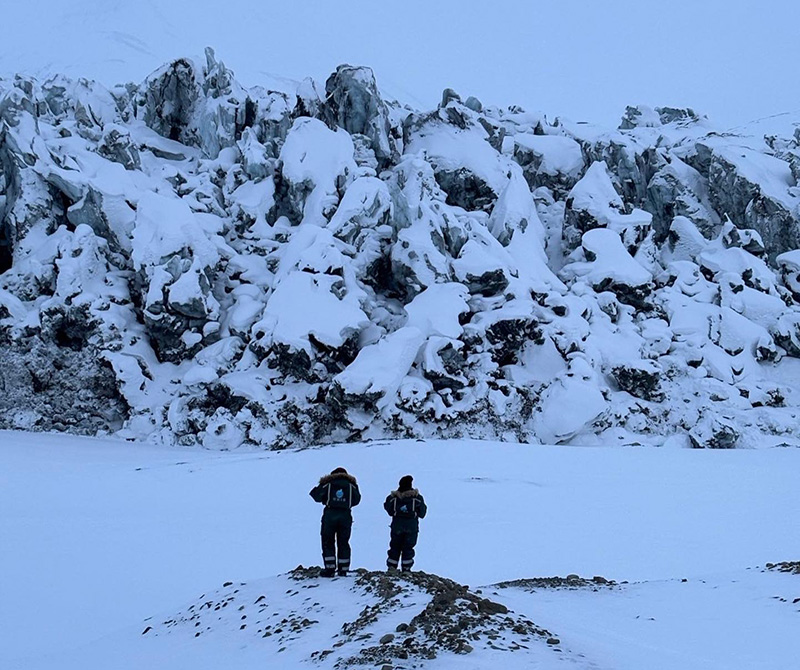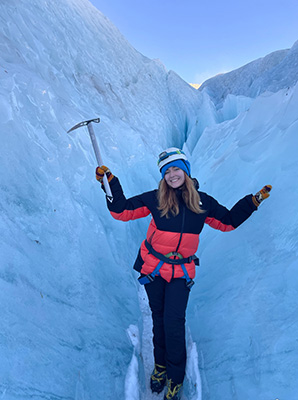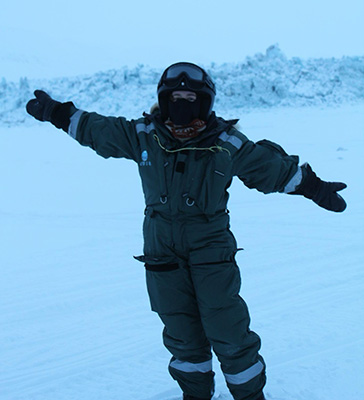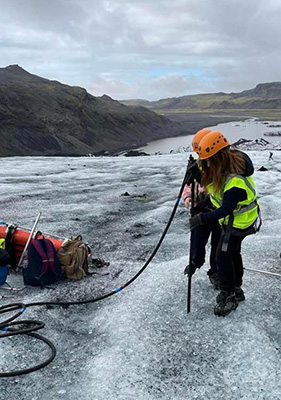
In February of this year, University of Iceland graduate student Chelsea Hill ’21 and a colleague examine the heavily crevassed surge front of the Vallåkrabreen glacier in Svalbard, an archipelago north of Norway.
Chelsea Hill traded Pennsylvania winters for the 24-hour darkness of Svalbard all because of her love of glaciers and what they can tell us about the earth. Born and raised in Bethlehem, Hill graduated from Moravian in 2021 and has used her education to propel her to international research.

While at Moravian, Hill explored many facets of environmental science. The course that would focus her interest was Climate Negotiations taught by Diane Husic, dean of the center for scholarship, research, and creative endeavors; director of the environmental studies and sciences program; and professor of biology. Husic invited world-renowned glaciologist Heïdi Sevestre, who works at the Arctic Monitoring and Assessment Programme in Tromsø, Norway, to speak to the class. It was Hill’s first exposure to glaciology, and it piqued her interest. She stayed in touch with the glaciologist, and for Hill’s final semester, Husic arranged an independent study in which Sevestre supervised Hill’s glaciological work virtually.
“Sevestre’s passion for glaciology was quite contagious!” says Hill whose own passion was ignited by “the opportunity to be able to combine my love for geology and devotion to advocating for the planet.” Hill attended a series of conferences, connected with other scientists in glaciology, and applied and was accepted into a master of science program in geology at the University of Iceland in Reykjavik to become a glaciologist herself.
Glaciologists study the physical properties and movement of glaciers. “Glaciers are the world’s most important tellers of climate change,” says Hill. “They contain thousands of years of data that tell us about the history of Earth’s climate. Unfortunately, they are melting at unprecedented speeds due to the rise of surface temperatures on Earth.”

In a field-based glaciology course in Svalbard—an archipelago north of Norway—Hill is working on her thesis in structural glaciology, which examines the way ice fractures and opens up into large crevasses on the surface. Additionally, she studies glacier landforms and movement.
In particular, she is analyzing glacier surges—temporary periods of accelerated ice flow–because they are still not entirely understood, and there is significant debate on whether or not climate change is impacting glacier surging. Her fieldwork will help the glaciological community understand surges more deeply, providing key research for the overall goal of expanding knowledge of glacier dynamics.
But how did Moravian prepare Hill for glaciology, graduate school, and life in a foreign country? Moravian professors are known for inspiring and encouraging students. Hill found these attributes and more with Husic, her professor and mentor, who pushed her to go above and beyond what was expected of her and helped her engage in undergraduate research. Hill notes that this encouragement opened the door “to really push myself out of my comfort zone to move across the ocean and go to these really harsh environments in the name of my love for glaciers!”

Through her undergraduate research, Hill interacted with scientists from all over the world. The confidence that grew from these interactions as well as the network that was formed prepared Hill for grad school, professional work, and academic research all in another country.
Living abroad has been one of the most surprising yet fulfilling parts of Hill’s post-Moravian experience. Even though English is commonly spoken in Iceland, Hill looks forward to learning Icelandic and about Icelandic culture through her work in Iceland’s largest natural history museum, Perlan. From Moravian to Iceland to Svalbard, Hill never expected her education to take her across the world or for her research to focus on glaciology, but she has found her passion and purpose. After finishing her master’s degree at the end of this summer, Hill looks forward to pursuing a PhD and possibly returning to Svalbard for continued research. What’s certain is that Hill will keep her passions for environmental advocacy and glacier research aflame.
—Gianna Tilly ’24